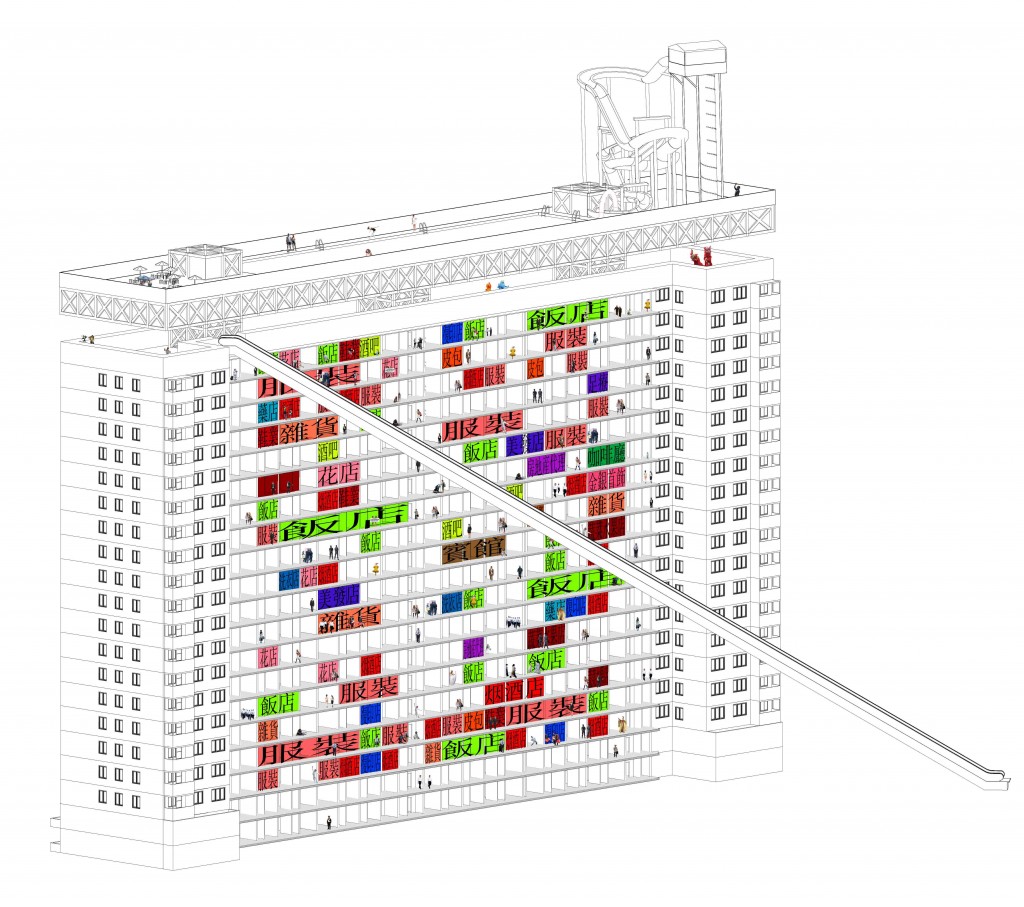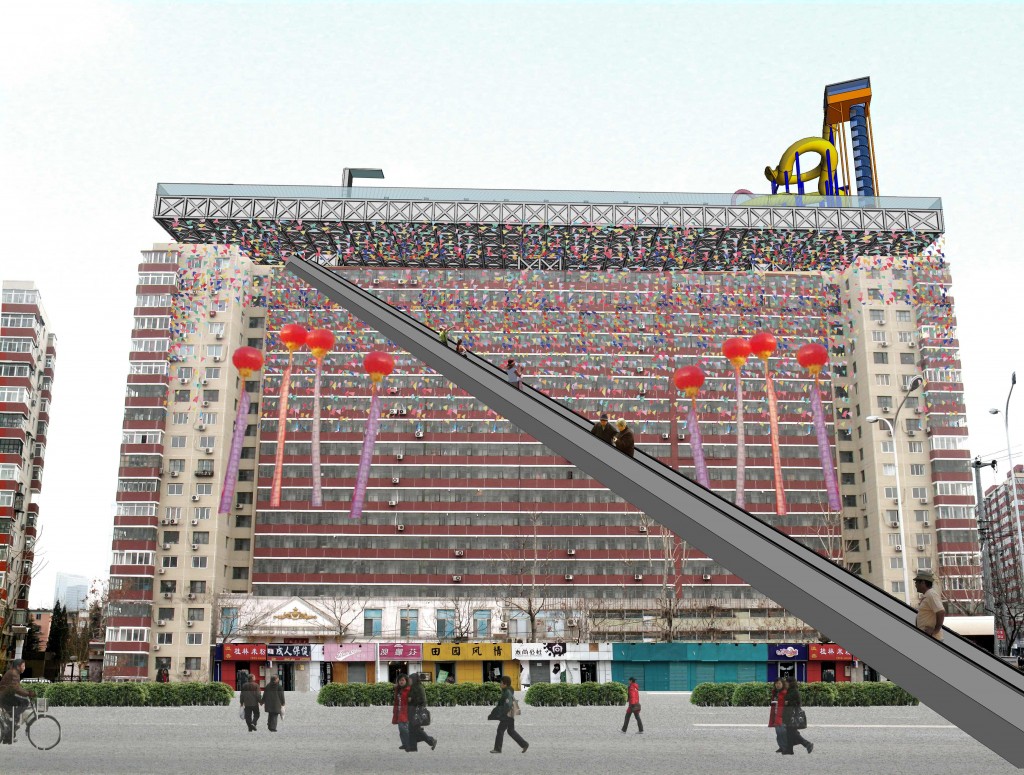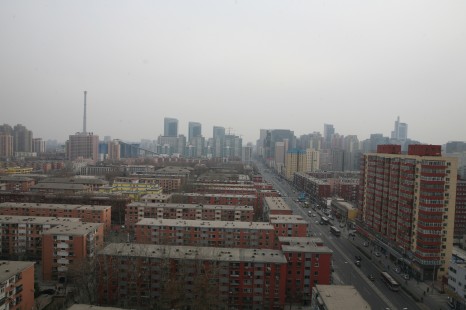Che Fei and CU OFFICE’s trans-community: Jin Street Model
车飞与超城建筑的超街区:“金街模型”
 Trans-Community space usage distribution. 金街模型空间利用展示。
Trans-Community space usage distribution. 金街模型空间利用展示。
 Trans-Community Façade. 金街模型外墙.
Trans-Community Façade. 金街模型外墙.
 Existing Community of Jintai, inside CBD Eastern Expansion Area. CBD内现有的社区金泰东扩区。
Existing Community of Jintai, inside CBD Eastern Expansion Area. CBD内现有的社区金泰东扩区。
车飞与超城建筑的超街区:“金街模型”
位于北京市CBD东扩区的“金街”(金台路街道),经过“迎奥运”的公共事件而从一个走向衰败的工人住宅区转型为一个商业活跃的开放社区。经过调研,这一模式的成功在于将从公共基金与市场商业的私人资本植入一个有效的开放合作平台之上,使公共利益与私人利益在当地的社会结构中实现平衡,确定有限的目标和可行的实现度,最终重新激活城市街道及其开放空间的商业活力,使之服务于整个社区的更新与恢复。商业和外部资本进入社区,使居民自治组织——居委会从管理机能转向服务机能,并带动整个封闭的居民社区转向开放。空间开放带来了投资和消费,使得社区经济状况迅速改善,房屋租售市场取代了原来的政府投入社区维护的单一经济政策,使社区恢复自我生长与修复的机能。
“金街”的成功模式主要发生在临街的低层住宅街道,而街道后面的一些高层居民楼,从这一事件中尽管得到了间接的利益,如租房率的提高,但是否可以和街道一样得到更为实质性的改变?CBD的东扩,将金台路街道的整个区域划在其中,以调研所发现的发展模式,是否可以改变社区拆迁,重新开发集中式商业建筑的旧有模式。将一个生机勃勃的开放社区拆除,不仅使地上建筑与经济基础荡然无存,也使得构成当地稳定与发展的社会结构被消除。因此,适度的保留健康的旧有街道组织,将新的开发因素慎重地置入,是本方案的思考出发点。因而,选择金台路街道尽端的一栋18层老式住宅楼进行改造,并引入金街发展模式(金台路街道奥运发展模式)作为其改造策略,使高层建筑也能融入到开放社区的可持续发展之中,具体的政策是:首先要将高层住宅的封闭性的私人空间改造为一个开放性的更具公共性的空间。引入公共资金在建筑的房顶设计建造开放的泳池平台等设施,并用独立的扶梯与街道连接,消除地面与顶层的高差,使得楼顶广场和泳池成为城市公共空间的共同组成部分。楼委会转型成为楼业资产发展办公室,服务于投资并经营楼内的公共资产。楼内现有的水平楼道转变为开放的街道,每个住宅可以自由选择经营或居住或出租。楼顶的公共设备将人流与城市活力引入内部,并最终促发服务业、零售业,餐饮与住宿以类似于金台路街道的构成比例在楼内形成,并融入到金台路街道的整体商业及街坊社会的结构框架之中。一种新型的高层商住混合体,实现对自身的管理,升级和改造。它打破了CBD迁除——建造——再迁除——再建造的破坏式开发逻辑。
对比SOM等设计公司提交的CBD发展方案,车飞和CU OFFICE的“金街模型”提出了完全相反的发展策略,保留当地文化与社区,通过公共资本,市场商业与地方社会的合作,选择可持续性的方式发展城市街区。通过研究成功的“社会街道”发展模式,并将其作为“移植策略”运用到城市发展中,最终实现本地化的“超街区”发展。最后,我们呼吁国家建立一个中国社区发展拨款计划,已实施类似的城市项目,以利于中国城市与社会的可持续发展。
Che Fei and CU Office’s trans-community: Jin Street Model
Following the public activity of “preparation for the Olympics,” Jin-Street, in Beijing’s CBD eastward expansion area, has been transformed from a declining workers’ residential area into an open and dynamic commercial community. The research has found that the success of the pattern lies in implanting public funds and the private capital of market business into an effective and open cooperation platform, thus balancing public and private interests in the local social structure and fixing limited goals and feasible realizations, and finally re-activating the commercial vigor of the urban streets and their open space to make it serve the renewal and recovery of the whole community. The function of the neighborhood committee—residents’ autonomy organization, has been transformed from management to service with the entry of commercial and outside capital, making the whole closed residential community open. The investment and consumption initiated by the opening of the space improve the economic condition of the community rapidly; the housing and renting market replaces the single economy policy of government input for community maintenance, making the community retrieve the function of self-generating and renovating.
The successful model of Jin-street mainly lies in low-rise residential buildings facing the streets, and the high-rise residential buildings behind the streets benefit indirectly from the event, like the increase of the occupancy rate; however, can they be changed more substantially like the streets? CBD Eastward Expansion Plan includes the whole area of Jintai Road; the development model found by the research institute is capable of changing the old model of community demolition and re-developing concentrated commercial buildings. The demolition of a vibrant open community not only clears the buildings and economic basis, but also eliminates the social structure for local stability and development. Therefore, the purpose of this program is the appropriate preservation of old healthy street organization and prudent implementation of the new developing factors. Thus, an old 18-storey residential building at the end of Jintai road is chosen for transformation, and Jin-street developing model (similar to the Olympics development model of Jin Street) is brought in as its transformation strategy; it will make high-rise buildings part of the sustainable development of an open community. The specific plans are as follows: the first step is to transform the closed private space of the high-rise building into an open and more public space. Public capital will be brought in to design and build a swimming pool and other facilities on the roof of the building, and separate escalators will be used to connect this to the streets for eliminating the altitude difference between the ground and roof-top, thus making the square and swimming pool on the roof componential parts of urban public space. The building’s management committee is transformed into the building’s industry asset development office to invest and manage the public asset of the building. The horizontal corridors are transformed into open streets and each house can be freely put into commercial, residential or renting purpose. The public facilities on the roof bring the vigor of the people and city inside the building, service industry, retail business, dining and accommodation industries will form in the building in proportion to those of Jin Street, and they will all blend into the entire commercial and neighborhood social structure of Jintai Road. A new model of high-rise compound building for commercial and residential use will realize self-management, upgrading and transformation. It breaks the CBD destructive developing logic of demolition—construction—re-demolition—re-construction.
Contrasting to the CBD development plan submitted by SOM and other companies, Che Fei’s and CU OFFICE’s “Jin-street model” proposes a completely opposite developing strategy that preserves the local culture and community, develops urban quarters sustainably through the cooperation of public capital, market business and local society. Through research into the successful ‘Social Street’ developing model and applying it in urban development as “transplanting strategy,” localized “trans-community” development will eventually be realized. Finally, we are also calling for the establishment of a national community development funding program, in order to implement similar city projects, facilitating sustainable developments of cities and communities in China.
CU OFFICE: www.cu-office.com
—–
Gentrification Disco

 时间 posted on: 27 March 2011 |
时间 posted on: 27 March 2011 |  发布者 author:
发布者 author: 
 分类 filed under:
分类 filed under: